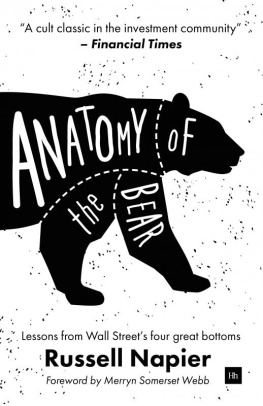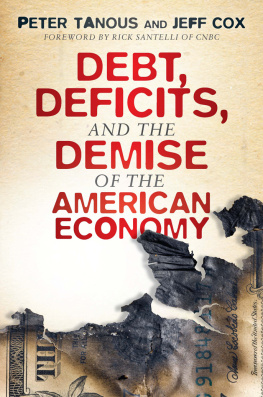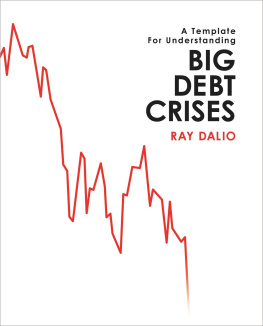The Asian Financial Crisis 199598
Birth of the Age of Debt
Russell Napier

Contents
Praise for The Asian Financial Crisis 199598
A combination of applied and highly practical economics that through reality bridges the gap between policy theory and actual implications and results, but more it is also a travelogue and a diary.
Richard Chenevix-Trench, Former CIO of Sloane Robinson
Russell Napiers book offers an authoritative and highly erudite account of one of the most consequential events that reshaped the modern world. As a market participant and a keen observer, Russell offers a seat at the table for anyone who wishes to understand the challenges facing todays policymakers and how the Asia Pacific crisis birthed the age of debt. It is an indispen sable guide.
Viktor Shvets, Global Strategist and Author of The Great Rupture: Three Empires, Four Turning Points and the Future of Humanity
A detailed retrospective on the development and evolution of the Asia Crisis drawn from the contemporaneous notes of a keen observer of economic and financial history interesting food for thought for investors and policym akers alike.
Terrence Checki, Former Executive Vice President and Head of Emerging Markets and International Affairs, Federal Reserve Bank of New York
The Asian crisis was a remarkable learning experience for everyone in finance. This blow by blow account is an important reminder of what we learned and the hard way we learned it.
Lord Davies of Abersoch, Ex Standard Chartered plc and previously Minister for Trade and Small Business
The Asian financial crises marked the dawn of a new strain of highly virulent crisis that would, in time, come to afflict every advanced economy in the world. This lucid book offers a forensic and compelling account of its source, contours and c onsequences.
Andy Haldane, Chief Economist at the Bank of England
For my colleagues at CLSA from 1995 to 1998
Forsan et haec olim meminis se iuvabit.
A joy it will be one day, perhaps, to remember even this.
The Aeneid
About the author
Professor Russell Napier has been an adviser on asset allocation to global investment institutions for over 25 years. He is author of Anatomy of The Bear: Lessons From Wall Streets Four Great Bottoms and Keeper of the Library of Mistakes, a business and financial history library based in Edinburgh. He has founded and runs a course called A Practical History of Financial Markets and also an online marketplace (ERIC) for the sale of high-quality investment research to institutions. Russell is Chairman of the Mid Wynd International Inves tment Trust.
Introduction and Acknowledgements
T his is another book abo ut mistakes.
In my last book Anatomy of The Bear: Lessons From Wall Streets Four Great Bottoms I chronicled, by analysing opinions expressed in the pages of the Wall Street Journal , why intelligent investors were so keen to sell equities when they subsequently produced excellent long-term returns. While financial history in general and the history of investment in particular focuses on the individuals and institutions that get things right, the story of those who get things wrong is often ignored. While spectacular failure often makes it into a footnote, conventional failure is the background noise that barely reaches beyond a gentle hum in the pages of financial history. I hope that in Anatomy of The Bear I showed how common errors, when equities were cheap in 1921, 1932, 1949 and 1982, provided excellent signals that it was time to invest.
In this book I assess contemporaneous opinion both at the top of the bull markets in Asian equities from 1995 to 1996 and also, following a vicious bear market from 1996 to 1998, such opinion at the bottom of the bear markets in September 1998. On this occasion I rely not on the pages of the Wall Street Journal to assess such opinion, but on my own writing as an Asian equity strategist working in Hong Kong throughout that period. Many of the mistakes in this book are my own mistakes. You will find my own contemporaneous opinions from 1995 to 1998 throughout this book in boxed sections. What you will read in these sections is not the history of the Asian economic miracle nor the Asian financial crisis. You will read what financial market practitioners thought would happen in Asia, but didnt. That is a very different story from financial history, but its the most important story for investors assessing why financial assets can become so misvalued. The opportunity for investors to profit was in determining the prevailing errors of analysis in Asian financial markets in 1995 and 1996. They were very different errors that signalled the bottom of the equity bear markets in Sep tember 1998.
The end of the so-called Asian economic miracle and the events of the Asian financial crisis were about much more than money. They were about a conflict between very different societies fought on the battleground of capital markets. It was the first major battle in a war that continues to this day and will shape the rest of the 21st century. It is a war that was instigated by a Thatcher/Reagan revolution that launched a new form of capitalism that sought to change the world, armed with excessive amounts of debt, in pursuit of profit. While initially it looked like an old form of what might be called laissez-faire capitalism, it very quickly became a new form of capitalism probably best labelled financial capitalism. It was a form of capitalism that combined individualism with the aggressive use of balance sheet management for primarily personal profit. As early as 1983, Michael Milken was helping corporate America supercharge returns through the issuance of a record amount of speculative credit instruments known as junk bonds. The particular beneficiaries of this form of financial engineering were corporate management and incentives were soon put in place, primarily in the form of stock options, to incentivise such behaviour. The world has seen speculative corporate debt binges before, but this one was launched in a period when interest rates had just begun a decline that would last 40 years. The heady mix of ever cheaper debt combined with ever more stock options incentivised corporate management to export financial capitalism to the world. A simple narrative developed that it would sweep all before it.
The rise of financial capitalism occurred as the Berlin Wall fell and communism collapsed. It was widely assumed that the rest of the world would adapt to a capitalist system and the new financial capitalism found itself with a seeming myriad of opportunities for profit and, it was argued, only weak competition. The fact that many stock markets across the world, closed primarily by communist regimes, had reopened was one signal that the change to a more capitalist structure was underway. However, these were dangerous surface signals because in many societies the new form of capitalism spreading from the US was incompatible with local societal beliefs and structures. Each society in Asia was different in its own way, but in north Asia in particular there was a much more communal approach to societal organisation that could not and has not been reconciled with financial capitalism. This book charts the battle between the new financial capitalism and the various other forms of capitalism that existed then and still exist a cross Asia.
The Asian financial crisis was for many a victory for financial capitalism over the various forms of Asian capitalism. This book will explain why in fact there was no such victory. Asian capitalism adapted but fundamentally did not change. In north Asia in particular their form of social capitalism was strengthened by the confrontation in 1998 that left them with significantly undervalued exchange rates and benefiting from the new debt-charged consumption growth of the developed world. The Asian financial crisis set the scene for an age of debt in the developed world and this brought crises that have forced developed governments to confront financial capitalism in their own backyards. The result is that the age of financial capitalism is ending and something more akin to the social capitalism of Asia is being created. This book looks at that battle fought in the capital markets in Asia in 1998 and explains how a seemingly lost battle set the scene for the dangerous overextension of financial capitalism. In that overextension, financial capitalism reached extremes that led to financial collapse and societal repercussions that were ultimately unacceptable to both peoples and their political representatives. When the history of the 21st century is written, it will begin with the Asian financial crisis of 1998, which created global financial conditions that created the age of debt and triggered a structural shift to a new form of social capitalism in the developed world. The repercussions from events in Asia in 1998 have been and will be much wider than merely financial.









